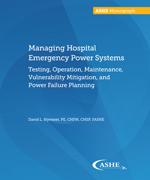Managing Hospital Emergency Power Systems: Testing, Operation, Maintenance, Vulnerability Mitigation, and Power Failure Planning

Hospitals face new requirements and more challenges today than ever before. These challenges demand a holistic approach to EP system management—blending utility management with emergency management and infrastructure master planning. Factoring in continuous quality improvement and staff education means that, moving forward, EP systems must be managed where many hospitals simply operated them in the past. More attention should also be paid to EP system maintenance, and that need brings its own set of issues. Our hospital EP systems must operate reliably when they are needed, for as long as they are needed, and provide power to their connected loads without failure. These requirements are daunting, and satisfying them is no easy task. This monograph describes a complete EP system management program intended to satisfy these needs that includes all elements of the emergency power reliability equation.
| Access PDF | Members can download a PDF of the entire monograph |
| Order print version | Catalog number: 055914 Member: $25.00, Nonmember: $35.00
|

